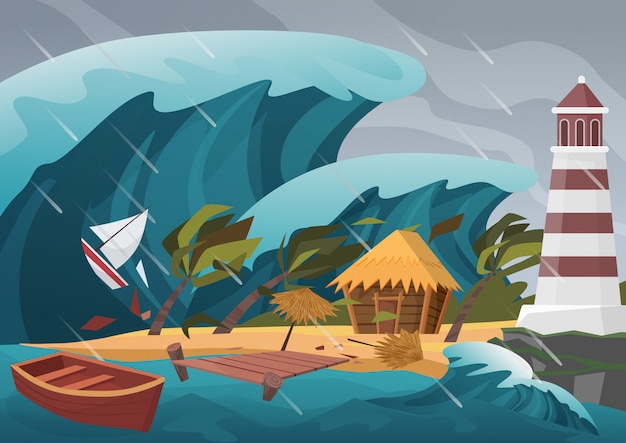Exploring Fascinating Facts about Tsunamis

Tsunamis can reach speeds of up to 500 miles per hour.
The word tsunami is Japanese and translates to harbor wave.
Tsunamis can be triggered by earthquakes, volcanic eruptions, or even meteor impacts.
The biggest recorded tsunami occurred in 1958 in Lituya Bay, Alaska, and had a height of 1,720 feet.
Tsunamis can travel across entire ocean basins, often reaching distant shores.
The Indian Ocean tsunami in 2004 was one of the deadliest natural disasters in history, claiming over 230,000 lives.
Not all earthquakes generate tsunamis, as the movement of tectonic plates must displace a large amount of water to create one.
Tsunamis can cause devastating damage to coastal infrastructure, including buildings, roads, and bridges.
Tsunamis can also impact marine ecosystems, causing damage to coral reefs and other underwater habitats.
The Pacific Ocean is often referred to as the Ring of Fire due to its high frequency of tsunamis and earthquakes.
Tsunamis can travel at different speeds depending on the depth of the water they are in.
Tsunamis can affect the behavior of marine animals, causing them to migrate or change their feeding patterns.
The height of a tsunami wave can increase significantly as it reaches shallow waters near the coast.
Early warning systems are in place to detect and alert coastal communities of an impending tsunami.
Tsunamis can create strong undercurrents and dangerous rip currents, making swimming or boating extremely hazardous.
Exploring Fascinating Facts about Tsunamis part 2
Tsunamis can sometimes cause the ocean to recede far from the shore before rapidly rushing back as a massive wave.
Despite their destructive power, tsunamis can also have positive effects, redistributing sediment and nutrients along coastlines.
Tsunamis have been depicted in various forms of art, literature, and film, often highlighting their devastating impact on humanity.
Some countries have tsunami-resistant building codes in place to mitigate damage and protect human lives.
Tsunamis can generate immense amounts of energy, equivalent to the explosion of thousands of atomic bombs.
The earliest recorded tsunami occurred in 479 BCE in Greece, causing massive flooding and destruction.
Tsunamis can travel across entire ocean basins in a matter of hours or even minutes.
Many organizations and experts are dedicated to researching and studying tsunamis to improve understanding and prediction.
Tsunami warning signs, such as the sudden retreat of ocean water or unusual animal behavior, should always be taken seriously.
Coastal communities can develop evacuation plans and safe zones to protect residents from tsunamis.
Tsunamis can produce powerful sound waves called tsunami thunders which resemble distant thunder or an approaching freight train.
Many coastal cities, such as New York and San Francisco, have experienced tsunamis in the past, highlighting the need for preparedness.
Tsunamis can cause landslides and trigger secondary hazards like flash floods and mudflows.
The length of a tsunami wave can extend for hundreds of miles, affecting vast stretches of coastline.
Tsunamis can amplify and be more destructive in narrow bays or fjords due to their shape and the reflection of waves.
Tsunamis can sometimes create strange phenomena, such as ghost ships or floating debris, carried far from shore.
Tsunamis have the potential to contaminate freshwater sources near the coast with saltwater, affecting local communities and agriculture.
Tsunamis have been important in shaping the geological features of many coastal landscapes around the world.
Certain animals, such as elephants, have shown an ability to detect the approach of a tsunami and seek higher ground.
Tsunamis can travel across the ocean without being noticeable on the surface, making them difficult to detect from ships or planes.
Tsunamis diminish in height and power as they move further away from their source.
Communities prone to tsunamis can create educational programs to inform residents about the risks and safety measures.
Tsunamis can generate powerful whirlpools known as seiches that can pull objects and even boats underwater.
Tsunamis are not only a threat to coastal areas but can also impact islands and even inland lakes.
Tsunami waves can break and crash multiple times, leading to prolonged periods of flooding and destruction.
Tsunamis can displace entire communities and force people to relocate due to the destruction of their homes and livelihoods.
Tsunamis have shaped cultural beliefs and folklore in many coastal regions, often being seen as a symbol of wrath or divine punishment.
Tsunamis can have long-term effects on the economy, with coastal tourism and fishing industries often taking years to recover.
The force of a tsunami can crush or destroy man-made structures, even those designed to withstand earthquakes.
Learning about tsunamis and their impact can help individuals and communities be better prepared and equipped to respond in case of an emergency.

